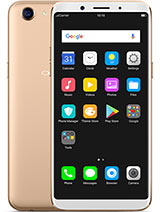Introduction
Probably every Huawei flagship - be it P-series or a Mate - has had a trusted companion, a Lite version to complement - and... well, compliment it. The flagship shines even brighter next to a less gifted stablemate. The Lite model in turn doesn't mind sharing some of the reflected light. It always works both ways and manufacturers are trying to get the best of it.Few of the Lites have succeeded in capturing the essence of the main act though - content with living in the flagship's shadow. Now, the Huawei Mate 10 Lite claims to be different.
 For the first time, we feel a Huawei Lite has been treated better than the usual repackage-and-discount routine. It's got a FullView widescreen, metal build, a pair of cameras on either side and the must-have large battery. It may be a Lite but it's a Mate, alright.
For the first time, we feel a Huawei Lite has been treated better than the usual repackage-and-discount routine. It's got a FullView widescreen, metal build, a pair of cameras on either side and the must-have large battery. It may be a Lite but it's a Mate, alright.Huawei makes a big deal of the Mate 10 Lite sporting four cameras and technically that's not an overstatement. True, the secondary 2MP shooters serve purely as depth sensors in portrait and a number of custom aperture modes - they can't help in low-light scenes. But those pro-grade effects seem to be highly souight after and making them available on a Lite is a smart move by Huawei.
Huawei Mate 10 Lite key features:
- Body: Metal frame, dual-glass design
- Screen: 5.9" IPS LCD of 1,080 x 2,160px resolution (409ppi)
- Camera: 16MP + 2MP dual-camera with phase-detection AF, f/2.2 aperture; LED flash; 1080p @ 30 fps video capture;
- Selfie cam: 13MP + 2MP f/2.0; 1080p @ 30fps video recording
- Chipset: 16nm Kirin 659, octa-core CPU (4xCortex-A53@2.36GHz + 4xCortex-A53@1.7GHz), dual-core Mali-T830 GPU
- Memory: 4GB of RAM, 64GB of storage; microSD slot (hybrid)
- OS: Android 7.0 Nougat with Huawei EMUI 5.1
- Battery: 3,340mAh Li-Po (sealed)
- Connectivity: Dual-SIM; LTE-A (Cat.6 300/50Mbps); microUSB; Wi-Fi b/g/n; GPS/GLONASS; Bluetooth 4.2
- Misc: Rear-mounted fingerprint reader
Main shortcomings:
- Hybrid DualSIM/microSD slot limits options.
- No Gorilla Glass
- No 5GHz Wi-Fi support, NFC, or FM radio
- No fast charging
 Still, we are looking at a midranger here, and the Mate 10 Lite packs more than enough punch to get us excited. We like the minimalist, clean design and the Aurora Blue paintjob is sure to turn heads. The super wide screen and the bokeh effects are enticing enough as well, and we'll hold the Mate 10 Lite to its promise of long battery life. Indeed, we have a lot to explore so let's get the review started, shall we?
Still, we are looking at a midranger here, and the Mate 10 Lite packs more than enough punch to get us excited. We like the minimalist, clean design and the Aurora Blue paintjob is sure to turn heads. The super wide screen and the bokeh effects are enticing enough as well, and we'll hold the Mate 10 Lite to its promise of long battery life. Indeed, we have a lot to explore so let's get the review started, shall we?Unboxing the Huawei Mate 10 Lite
It may be a thin cardboard box the Huawei Mate 10 Lite arrives in but it's not too slim on contents. We got a regular 10W charger, a microUSB cable and a cheapish set of earphones with a mic.There is also a transparent case too but we think the Mate 10 Lite's metal shell might do just fine without it. Not that it's scratch-proof - sadly, no - but it's too good-looking perhaps to warp into a plastic case. Still, we appreciate the bundle considering the price tag.
Design
Instead of borrowing the dual-glass design from the flagship Mate 10s, the Huawei Mate 10 Lite sticks to the traditional aluminum unibody. And we are fine with that. Lite in the middle Near six inches of an 18:9 FullView screen should be enough to make the Lite as relevant in the midrange as its premium Mates are in the top tier. Yet, Huawei took the extra mile and included some of the premium imaging experience you get on the flagships, sans the artsy monochrome shots.
Lite in the middle Near six inches of an 18:9 FullView screen should be enough to make the Lite as relevant in the midrange as its premium Mates are in the top tier. Yet, Huawei took the extra mile and included some of the premium imaging experience you get on the flagships, sans the artsy monochrome shots. FullView showdown, Lite in the middle So, the Lite's front is mostly screen - that being the standout feature of the season. The 5.9" IPS display looks punchy, with plenty of resolution and should be capable enough of providing an immersive multimedia experience. The bezels are quite slim and the two tiny selfie cams don't get in the way at all. The screen glass has a nice 2.5D finish but the origin is unspecified - likely not Gorilla-glass, which may become an issue in the long run.
FullView showdown, Lite in the middle So, the Lite's front is mostly screen - that being the standout feature of the season. The 5.9" IPS display looks punchy, with plenty of resolution and should be capable enough of providing an immersive multimedia experience. The bezels are quite slim and the two tiny selfie cams don't get in the way at all. The screen glass has a nice 2.5D finish but the origin is unspecified - likely not Gorilla-glass, which may become an issue in the long run. The back is flat, clean and stylish but the antenna strips are a little too prominent perhaps than we've grown used to seeing lately. There are quite a few clever takes on the shape of those but somehow the straight lines don't look too bad on the Mate.
The back is flat, clean and stylish but the antenna strips are a little too prominent perhaps than we've grown used to seeing lately. There are quite a few clever takes on the shape of those but somehow the straight lines don't look too bad on the Mate. The dual-camera setup is bulging just a tiny bit, while its LED flash is oddly breaking the top antenna line. Quite discreet at first inspection, the fingerprint scanner is impressively fast. And it's always-on, of course, so touching it unlocks the phone even from standby.
The dual-camera setup is bulging just a tiny bit, while its LED flash is oddly breaking the top antenna line. Quite discreet at first inspection, the fingerprint scanner is impressively fast. And it's always-on, of course, so touching it unlocks the phone even from standby. There are no sharp bits at all, the metal frame of the Mate 10 Lite is subtly curved and it's hard to tell where the frame ends, and the back starts. Other than a boost to looks, this gives the handset an extra pleasant feel in hand - although at the expense of a secure grip. Even with the matte finish, the body feels slippery - there are just no edges to hold on to. And considering the phone is supposed to be used a lot for taking pictures, the supplied case might not be such a bad idea after all.
There are no sharp bits at all, the metal frame of the Mate 10 Lite is subtly curved and it's hard to tell where the frame ends, and the back starts. Other than a boost to looks, this gives the handset an extra pleasant feel in hand - although at the expense of a secure grip. Even with the matte finish, the body feels slippery - there are just no edges to hold on to. And considering the phone is supposed to be used a lot for taking pictures, the supplied case might not be such a bad idea after all.
A cool 18:9 screen with 5.9" diagonal
The Huawei Mate 10 Lite packs a 5.9" IPS LCD with an 18:9 aspect ratio, in line with the flagship 10-series Mates. The resolution is 1080p, making for a reasonably sharp 409ppi. Huawei does not specify the type of screen glass used on the Mate 10 Lite, so we can't verify its strengths or weaknesses. It's 2.5D-shaped at edges, which looks cool. Some markets may be getting the Lite with an additional pre-applied screen protector, but that wasn't the case with our unit.
Huawei does not specify the type of screen glass used on the Mate 10 Lite, so we can't verify its strengths or weaknesses. It's 2.5D-shaped at edges, which looks cool. Some markets may be getting the Lite with an additional pre-applied screen protector, but that wasn't the case with our unit.The IPS LCD offers impressively deep blacks and a good maximum brightness of 482 nits resulting in an excellent contrast ratio of 1852:1.
As for color accuracy, the Mate 10 Lite screen posts an average deviation (DeltaE) of 5. There are no color settings, so you are stuck with the extra punch you get right of the box.
| Display test | 100% brightness | ||
| Black, cd/m2 | White, cd/m2 | ||
| 0.257 | 476 | 1852 | |
| 0.351 | 560 | 1595 | |
| 0.3 | 415 | 1383 | |
| 0.376 | 591 | 1572 | |
| 0.351 | 551 | 1570 | |
| 0.357 | 546 | 1529 | |
| 0 | 441 | ∞ | |
| 0.289 | 515 | 1782 | |
| 0.288 | 510 | 1771 | |
| 0.297 | 431 | 1451 | |
Battery life
The Huawei Mate 10 Lite is powered by a non-removable 3,340mAh battery. The phone ships with a charger capable of outputting 5V/2, which means a maximum power output of 10W. A 30-minute session will restore about 33% of the battery charge. A full recharge takes about two and a half hours.Huawei Mate 10 Lite posted an endurance rating of 76h. That's slightly above average number and about right for a 16nm chipset. The performance in the individual test routines - standby, call, and web - is quite promising but it was let down by its relatively higher power draw in video playback.

Our endurance rating denotes how long a single battery charge will last you if you use the Huawei Mate 10 Lite for an hour each of telephony, web browsing, and video playback daily. We've established this usage pattern so our battery results are comparable across devices in the most common day-to-day tasks. The battery testing procedure is described in detail in case you're interested in the nitty-gritties. You can also check out our complete battery test table, where you can see how all of the smartphones we've tested will compare under your own typical use.
Connectivity
The Huawei Mate 10 Lite is a dual-SIM phone (using a hybrid slot means you have to lose the extra line if you need to expand the storage with a microSD card). It offers LTE Cat. 6 for up to 300Mbps of download and up to 50Mbps upload.The phone supports Wi-Fi 802.11 b/g/n for 2.4GHz but 5GHz networks are a no-go (it's single-band Wi-Fi). In contrast, the Huawei P10 Lite has dual band Wi-Fi support.
The rest of the connectivity options on the Huawei Mate 10 Lite include Bluetooth 4.2 LE, A-GPS, GLONASS. There is no NFC, IR blaster, or FM radio though.
Wired connectivity is handled by a microUSB 2.0 port. There's no Type-C here unlike the flagship Mate 10. USB On-The-Go is supported so you can connect peripherals. There's no wired TV-out option but you have DLNA support anyway.
Finally, there's a 3.5mm headphone jack and the phone ships with a headset in the bundle.
Android Nougat with EMUI 5.1
The Huawei Mate 10 Lite runs on EMUI version 5.1 based on the aging Android 7.0 Nougat OS. There is a more recent EMUI 8 with Android Oreo, but for now this ROM is exclusive to the Mate 10 flagship duo. And while the Mate 10 Lite may not be sporting the latest version, it's still quite similar to what the bigger Mates got. The Magazine unlock style for the lockscreen is here to stay. It greets you with a different wallpaper every time you wake up the device. You can also quickly start the camera by a double press of the Volume Down button, with the option to take a snap right away.
The Magazine unlock style for the lockscreen is here to stay. It greets you with a different wallpaper every time you wake up the device. You can also quickly start the camera by a double press of the Volume Down button, with the option to take a snap right away.If you opt for a fingerprint unlock method, you probably won't be seeing much of the lockscreen anyway. Almost a shame, considering all the effort that Huawei has put into making it unique. Still, the reader is blazing fast and using it is a no-brainer.
On top of the usual all-apps-on-the-homescreens approach EMUI 5.1 gives you the option to pick the standard Android two-tiered interface with homescreens for your most-used apps and an app drawer for all of them.
App twins for multiple instances of a single application is available on the Mate 10 Lite.
EMUI 5.1 has Theme support, of course. The theme store offers a wide selection and some really artsy options that fit in well with the general high-design image of the Mate 10 Lite. Of course, you can always keep things simple and only customize the wallpaper and possibly transition animations.
The notification area is a 50/50 mix between stock Nougat and Emotion. Huawei has tweaked the look of the quick toggles and added the auto-brightness switch, which Google so stubbornly refuses to keep in plain sight. The notifications themselves look just like the Pixel's.
The task switcher is rather straightforward, with a Kill All option.
There are a few other interesting tweaks you can apply to the status bar. For example, notification icons can be replaced by a simple numerical counter. You also have control over whether the notification LED and display should react to a new notification.
The Mate 10 Lite features granular notifications control - Huawei had that even before it was a part of Android itself. You can control which apps can send you the three types of available notifications - the shade notifications, the lockscreen notifications and the banner style notifications.
Last, but not least, there is a dedicated menu for controlling crucial permission on a per-app basis. It's a great addition, since you don't want a random app ignoring the system's attempts to optimize its power consumption or drawing over other applications.
While these are options accessible from the settings menu, most of them are also featured in the Phone Manager app. There you'll also find a one-touch optimization button. A virus scanner powered by Avast is on board as well. There are power-saving modes with granular settings, too.
You can also enable the so-called Floating dock - it's a virtual key you can move anywhere on the screen, allowing you to expand it to the primary Android keys - Back, Home, Task Switcher, Lock and Close all running apps. It will help you control your phone with just one hand. There are other interesting alternative controls as well, like the ability to map the buttons on your headphones to various actions.
Motion control also plays a significant role on the Mate 10 Lite like it did on previous Huawei models. There are flip gestures, as well as picking up, tilting and even things like knuckle detection and drawing. All of those are extensively customizable to your liking.
Performance
The Huawei Mate 10 Lite is powered by the Kirin 659 chipset developed in-house by Huawei's HiSilicon subsidiary. It's a minor step over the Kirin 658, obviously. It has an octa-core CPU with eight A53 cores. Four of those take the heavy lifting and work at 2.36GHz, while the other four take care of less power-intensive tasks while ticking at 1.7GHz.The GPU in charge of graphics is a dual-core Mali-T830, and Huawei also throws in 4 gigs of RAM.
 The 659 chip has 10MHz higher clock for the faster CPU quarter and newer Bluetooth 4.2 support when compared to the 658 model. It's dropped the 5GHz Wi-Fi connectivity though.
The 659 chip has 10MHz higher clock for the faster CPU quarter and newer Bluetooth 4.2 support when compared to the 658 model. It's dropped the 5GHz Wi-Fi connectivity though.The chip is built on a 16nm fabrication process, which isn't the most power-efficient process used for mid-range chipsets right now, but not that far behind the widespread 14nm either. So we expect the Kirin 659 to keep the phone rather cool at full throttle.
We kick off our benchmark routine with some processor torture as usual. A single A53 core can't get you very far on Geekbench, but at least its result offers consistent midrange performance results.
Huawei Mate 10 Lite is well equipped for the class and won't fail you at any task. It handles organizing tasks hassle-free, and we had no issues playing popular games, though loading takes a while and hiccups do happen. The phone runs cool even at full throttle, so don't expect any heat issues no matter how you use it. It isn't a chart topper, sure, not even next to fellow mid-ranges, but the Mate 10 Lite offers balanced performance, and that's enough.
Telephony
The Mate 10 Lite dialer has a shared interface with the contacts app. There are no groundbreaking features here, but there is nothing missing either.The dual-SIM settings menu (where available) lets you rename the SIM cards, disable them, and select which one does calls or data by default.
Loudspeaker
There is one speaker on the Mate 10 Lite and it's at the bottom. It scored a Very Good mark in our loudness test. The sound quality is very good, too, but not as impressive as on the Mate 10. The sound is a bit shallow, but we've heard a lot worse, so for the mid-range class we'd say the Mate 10 Lite does just great.| Speakerphone test | Voice, dB | Ringing | Overall score | |
| 66.0 | 65.8 | 66.6 | Below Average | |
| 63.5 | 70.8 | 71.5 | Average | |
| 67.8 | 72.9 | 73.3 | Good | |
| 67.2 | 71.1 | 80.7 | Good | |
| 67.3 | 70.3 | 81.5 | Very Good | |
| 68.5 | 72.5 | 80.1 | Very Good | |
| 67.8 | 71.0 | 84.5 | Very Good | |
| 70.9 | 75.3 | 88.0 | Excellent | |
| 74.0 | 73.9 | 90.4 | Excellent | |
| 90.6 | 73.7 | 84.0 | Excellent | |
| 88.9 | 77.8 | 84.6 | Excellent |
Pre-installed apps
There are a few apps pre-installed on the Mate 10 Lite. Among the more notable ones is the Health app, which tracks steps and calculates calories, but can also supposedly count the number of floors you've climbed.You also have a ton of basic tools preloaded, including a proper file manager, calendar app, notes, weather, compass, sound recorder, and flashlight.
Pictures, video, and music
The Huawei Mate 10 Lite comes with the familiar EMUI gallery on board. In addition to your camera roll, it offers sorting by albums, or smart sorting by subject, places, events, among others.The EMUI gallery has its own image editor, if needed, and it also works with variable aperture shots for adjusting the bokeh effects post factum.
The Mate 10 Lite also comes with a pre-installed Video app, which offers basic controls but supports pop-up play.
The EMUI's Music app is very nice. Its background changes dynamically to match the album art, which is a nice little touch. Lyrics are available and downloaded automatically. Finally, Huawei's Histen sound effects are available on the Mate 10 and include equalizers and simulated 3D audio.
Audio output is quiet but clear
The Huawei Mate 10 Lite did well in our audio quality test as far as the accuracy of its output is concerned. The phablet had no weak points to its performance with an active external amplifier and plugging in a pair of headphones caused very little damage.Loudness wasn’t nearly as impressive though and the Mate 10 Lite was well below average in both runs. That might be worth keeping in mind in case you have high-impedance headphones as the smartphone might be unable to produce loud enough output.
| Test | Frequency response | Noise level | Dynamic range | THD | IMD + Noise | Stereo crosstalk |
| +0.03, -0.03 | -89.2 | 89.2 | 0.0092 | 0.016 | -83.8 | |
| +0.13, -0.24 | -88.6 | 88.6 | 0.0050 | 0.148 | -61.2 | |
| +0.04, -0.02 | -88.2 | 88.6 | 0.011 | 0.021 | -84.3 | |
| +0.13, -0.05 | -87.4 | 87.7 | 0.014 | 0.084 | -75.9 | |
| +0.06, -0.08 | -93.5 | 93.3 | 0.0020 | 0.0071 | -93.2 | |
| +0.64, -0.07 | -89.3 | 91.3 | 0.0093 | 0.361 | -52.0 | |
| +0.05, -0.28 | -91.9 | 92.2 | 0.0037 | 0.051 | -90.3 | |
| +0.18, -0.05 | -91.0 | 91.6 | 0.019 | 0.230 | -57.9 |

Huawei Mate 10 Lite frequency response
Four cameras at your service
The Huawei Mate 10 Lite has a dual camera system on the front as well as on the back, which is how Huawei got the 'World's first phone with four cameras' rhetoric. The thing is, though, only two of those actually take pictures and the other two are depth sensors for the background blur effect. There is a 16MP main camera with f/2.2 lens and phase-detect AF on the back, accompanied by a 2MP sensor for depth information, and a single LED flash. A 13MP sensor sits behind f/2.0 lens at the front with another 2MP cam for depth data.
There is a 16MP main camera with f/2.2 lens and phase-detect AF on the back, accompanied by a 2MP sensor for depth information, and a single LED flash. A 13MP sensor sits behind f/2.0 lens at the front with another 2MP cam for depth data.Portrait mode with and without beautify is available for both snappers, while the variable aperture mode works only for the rear camera.
The camera interface is familiar as we have already seen it on the P10 and Mate 10 phones. The options are hidden in menus you can bring up by swiping left or right from the screen (assuming you hold the camera in portrait mode). This may be confusing at first, but you quickly get used to it. The main menu houses all the available shooting modes - Photo, HDR, Panorama, Pro, Beauty, Light Painting, among others. There is also an advanced settings menu, summoned by a swipe from the top.
The Huawei camera app offers a Manual (Pro) mode, which manual focus, shutter speed (up to 8s), ISO, and a few other options. The Pro camera interface is very easy to use.
Image quality
The 16MP samples we took in broard daylight came out with moderate resolved detail, a bit soft, but with true to life colors. The dynamic range is about average. The noise levels are reasonably low, but they spike a lot in skies and shadowy spots. The samples are fine for the class, but not the best we've seen.There is HDR mode available on the Mate 10 Lite, but we feel you'll rarely need it. There is often more than enough detail in the shadows (and noise, a lot of noise), while some of the highlights might be blown yet the samples look rather balanced. Turning HDR on won't improve things much, so what you get in the auto mode is close to the best the phone is capable of.
The low-light shots taken with the Mate 10 Lite are nothing to talk about. They would do for sharing but won't pass any pixel-peeping inspection as the noise gets in the way of everything. The samples aren't bad, just plain mediocre. But that's just fine for the class.
You can get two different types of high-quality low-light samples on the Mate 10 Lite, though, if you have a tripod or at least a place where you can leave the phone still. You can either use the Light Painting mode, where the Lite takes a picture with default settings and then captures only the moving lights imitating a professional long exposure shot of say, car speeding along the road.
Or use the Pro (manual) mode to tweak all settings by yourself using some long shutter speeds and get a bright and detailed low-light image.
You can check out how the Huawei Mate 10 Lite camera stacks up against the Oppo F5 and HTC U11 Life in our Photo compare tool.
Panorama
The panorama mode is one of the better implementations, switching automatically between portrait and landscape. When shooting in portrait, panoramic images turn out just over 3,000 pixels tall and the sample below is about 20MP. Stitching is good, exposure is even, and the captured detail is above average and the dynamic range is vey good.Variable aperture
Thanks to the depth information from the second 2MP camera, the Mate 10 Lite offers Variable Aperture. The Variable Aperture feature is accessed from the Wide aperture mode toggle and lets you simulate apertures from f/0.95 to f/16.As with all such implementations, the shots wouldn't hold up to closer scrutiny. The Mate 10 Lite variable aperture shots aren't as good as on the flagship Mate 10 either, as the separation of the subject is quite bad. But there are occasions where you could capture some nice shots if the object has a simple shape and the light is in your favor.
Portrait
The Portrait Mode is available on both the main and selfie snappers. It combines the Variable Aperture with Beautification and should offer Portrait shots with simultaneously enhanced faces and bokeh background effects.The recognition isn't perfect, and you can see traces of the background or some chopped details from the person. This mode isn't as professional grade as on the flagships, but we expected a bit more. Still, those would do for the social networks.
Selfies
The selfie camera on the Mate 10 Lite has 13MP resolution and f/2.0 lens. It also comes with portrait shooting mode thanks to the secondary 2MP front cam, which is able to create a bokeh for your selfies.The regular samples turned out fine, detailed and with pleasing colors, but the noise levels are quite highs. We've seen better, but we've seen a lot worse, so the Lite's samples are above the average in quality.
The Portrait Mode simulates bokeh alright, while it can also applies beautification effects on your face. The algorithm does a mostly fine job at recognizing your face and blurring the background, but there are noticeable artefacts here and there and once again - we just expected more. Vivo V7+ does much better portrait selfies and it has one camera at the front!
Video camera
The Huawei Mate 10 Lite can record 1080p videos at 30fps. There's no 1080p @ 60fps or 4K recording. The clips are recorded in MP4 files with a bitrate of 17Mbps. Audio is captured at a good 192Kbps (48kHz) rate, in stereo of course.The video quality doesn't quite live up to our expectations. The image isn't as sharp as some competing phones in this class, the dynamic range is not on par with the still images. The noise is kept low though, and the colors and contrast are very good.
As usual, we've provided an unedited sample straight out of the camera for you to download - 1080@30fps (10s, 22.6MB).
Be sure to head over to our video compare tool to check where the Mate 10 Lite stands against the Oppo F5 and the P10 Lite's 1080p videos. You can choose other cameras if you like.
Wrapping it up
For the first time it feels like a Lite is borrowing more than just the name of the headliner. The Mate 10 Lite has the FullView screen of the Mate 10, portrait mode for both regular and selfie photos thanks to a 4-camera system, a premium unibody and a big battery. But the Mate 10 Lite is still a 'lite' model, so there were a few compromises made along the way. Performance is nowhere near the big Mates. The image quality won't be leaving any long-lasting impressions either, the portrait mode works but is far from great. Even the wide screen is short of the resolution of the regular Mate 10. It's almost the same as the Mate 10 Pro's at near 6 inches of Full HD - only, not AMOLED.
But the Mate 10 Lite is still a 'lite' model, so there were a few compromises made along the way. Performance is nowhere near the big Mates. The image quality won't be leaving any long-lasting impressions either, the portrait mode works but is far from great. Even the wide screen is short of the resolution of the regular Mate 10. It's almost the same as the Mate 10 Pro's at near 6 inches of Full HD - only, not AMOLED.Yet, the Mate 10 Lite has hit the sweet spot between the premium and the basic, and that's what makes a good midranger. There is a great aluminum body with catchy paintjobs and a pleasingly immersive screen. The balanced chipset and good all round camera performance have each been enhanced with background battery management and portrait/beauty effects.
We could have asked for a more up-to-date Android and EMUI versions, wider aperture, enhanced connectivity or faster charging. But we guess Huawei balanced those omissions against the retail price. The thinking must've been: there is the Mate 10 proper and Pro for those who want more.
Huawei Mate 10 Lite key test findings
- Stylish and minimalist metal design but the grip is far from secure. No Gorilla Glass.
- The IPS LCD screen has enough sharpness, very deep blacks, superb contrast, and brightness. Color accuracy is fine, while the sunlight legibility is average for an LCD unit.
- Above average battery life at 76 hours only brought down by the mediocre web browsing times.
- EMUI is a feature-rich Android skin, though not without its quirks. Huawei has worked on polishing single-handed operation and it shows. A newer Android version would have been better though.
- The Kirin 659 chipset has enough CPU and GPU punch for the class and the phone handles routine jobs and more demanding tasks equally well.
- The onboard speaker scored a Very Good mark at the loudness test.
- Audio output via the analog jack is pleasingly crisp, but it's quieter than average and is not a good match for high-impedance headphones.
- Still images are average in terms of detail, with accurate colors, and good dynamic range. The panoramic samples turned good too. Mediocre low-light quality but enhanced with creative shooting modes.
- Average selfie pictures - somewhat soft with moderate detail.
- Portrait mode available on both the rear and front cameras, subjects are properly separated from the background but the results are far from spectacular.
- The 1080p videos came out with average detail but good colors, contrast and decent dynamic range.
The competition
There aren't so many midrange phones out there yet to offer a trendy 18:9 display and half of those are a mission impossible to get outside of Asia. The Oppo R11s or the cheaper Oppo F5, as well as the Vivo V7+ all have wide screens, solid metal builds and strong imaging credentials. But you can mostly find them in China and India. If that's where you are, all three of them are worth a look - they pretty much deliver on the promises.The LG Q6 is a global device with a 5.5" 18:9 screen but it can't match the premium build and camera experience of the Mate 10 Lite. There is also the inferior Snapdragon 435 chipset, but on a positive side it should be more battery-efficient.
The Sony's Xperia XA1 Plus offers a decent 16:9 screen, attractive design and a high-res 23MP main camera. The Xperia is also excels in battery life and plays along well with other Sony devices.
The HTC U11 Life and the Moto X4 are both part of the Android One program, run Oreo and enjoy on-time updates by Google. They sport regular 16:9 screens but run on faster chips. The Moto X4 has a dual-camera at the back that can capture 4K videos. The U11 Life has some exceptional audio skills in turn and high-quality noise-cancelling headphones in the package, so the audiophiles should take note.
If the super wide screen is not a top priority, then give the cheaper Xiaomi Mi A1 or Redmi Note 4 a chance and you may find yourself surprised. The Mi A1 has a pretty good dual-camera, while the Note 4 is half the Mate 10 Lite's price.
The verdict
So, the Mate 10 Lite is not a mini and we don't just mean the near six-inch screen. It's just not like most of them minis living off the flagship hype. No, you do get a reasonably good performer with the right touch of premium, both on the inside and the outside. The Huawei Mate 10 Lite gets some good stuff from the Mate 10 in terms of screen, imaging experience and battery backup. A Mate in looks and a Lite in price sounds like the right balance and the output is well up to standard. Worth a try.
The Huawei Mate 10 Lite gets some good stuff from the Mate 10 in terms of screen, imaging experience and battery backup. A Mate in looks and a Lite in price sounds like the right balance and the output is well up to standard. Worth a try.





















































































































Comments
Post a Comment